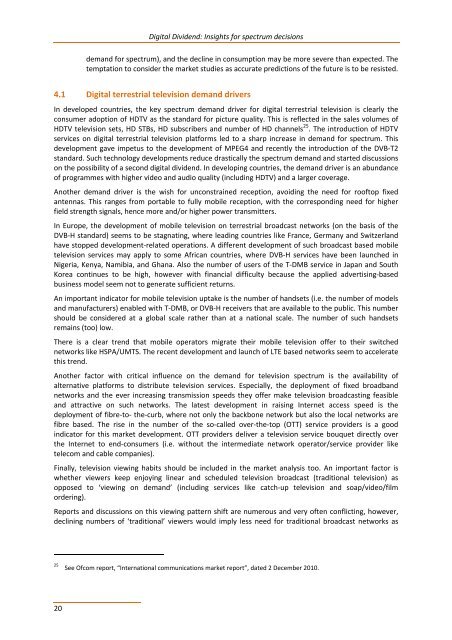Digital Dividend: Insights for spectrum decisions - ITU
Digital Dividend: Insights for spectrum decisions - ITU
Digital Dividend: Insights for spectrum decisions - ITU
- No tags were found...
Create successful ePaper yourself
Turn your PDF publications into a flip-book with our unique Google optimized e-Paper software.
<strong>Digital</strong> <strong>Dividend</strong>: <strong>Insights</strong> <strong>for</strong> <strong>spectrum</strong> <strong>decisions</strong>demand <strong>for</strong> <strong>spectrum</strong>), and the decline in consumption may be more severe than expected. Thetemptation to consider the market studies as accurate predictions of the future is to be resisted.4.1 <strong>Digital</strong> terrestrial television demand driversIn developed countries, the key <strong>spectrum</strong> demand driver <strong>for</strong> digital terrestrial television is clearly theconsumer adoption of HDTV as the standard <strong>for</strong> picture quality. This is reflected in the sales volumes ofHDTV television sets, HD STBs, HD subscribers and number of HD channels 25 . The introduction of HDTVservices on digital terrestrial television plat<strong>for</strong>ms led to a sharp increase in demand <strong>for</strong> <strong>spectrum</strong>. Thisdevelopment gave impetus to the development of MPEG4 and recently the introduction of the DVB-T2standard. Such technology developments reduce drastically the <strong>spectrum</strong> demand and started discussionson the possibility of a second digital dividend. In developing countries, the demand driver is an abundanceof programmes with higher video and audio quality (including HDTV) and a larger coverage.Another demand driver is the wish <strong>for</strong> unconstrained reception, avoiding the need <strong>for</strong> rooftop fixedantennas. This ranges from portable to fully mobile reception, with the corresponding need <strong>for</strong> higherfield strength signals, hence more and/or higher power transmitters.In Europe, the development of mobile television on terrestrial broadcast networks (on the basis of theDVB-H standard) seems to be stagnating, where leading countries like France, Germany and Switzerlandhave stopped development-related operations. A different development of such broadcast based mobiletelevision services may apply to some African countries, where DVB-H services have been launched inNigeria, Kenya, Namibia, and Ghana. Also the number of users of the T-DMB service in Japan and SouthKorea continues to be high, however with financial difficulty because the applied advertising-basedbusiness model seem not to generate sufficient returns.An important indicator <strong>for</strong> mobile television uptake is the number of handsets (i.e. the number of modelsand manufacturers) enabled with T-DMB, or DVB-H receivers that are available to the public. This numbershould be considered at a global scale rather than at a national scale. The number of such handsetsremains (too) low.There is a clear trend that mobile operators migrate their mobile television offer to their switchednetworks like HSPA/UMTS. The recent development and launch of LTE based networks seem to acceleratethis trend.Another factor with critical influence on the demand <strong>for</strong> television <strong>spectrum</strong> is the availability ofalternative plat<strong>for</strong>ms to distribute television services. Especially, the deployment of fixed broadbandnetworks and the ever increasing transmission speeds they offer make television broadcasting feasibleand attractive on such networks. The latest development in raising Internet access speed is thedeployment of fibre-to- the-curb, where not only the backbone network but also the local networks arefibre based. The rise in the number of the so-called over-the-top (OTT) service providers is a goodindicator <strong>for</strong> this market development. OTT providers deliver a television service bouquet directly overthe Internet to end-consumers (i.e. without the intermediate network operator/service provider liketelecom and cable companies).Finally, television viewing habits should be included in the market analysis too. An important factor iswhether viewers keep enjoying linear and scheduled television broadcast (traditional television) asopposed to ‘viewing on demand’ (including services like catch-up television and soap/video/filmordering).Reports and discussions on this viewing pattern shift are numerous and very often conflicting, however,declining numbers of ‘traditional’ viewers would imply less need <strong>for</strong> traditional broadcast networks as25See Ofcom report, “International communications market report”, dated 2 December 2010.20






